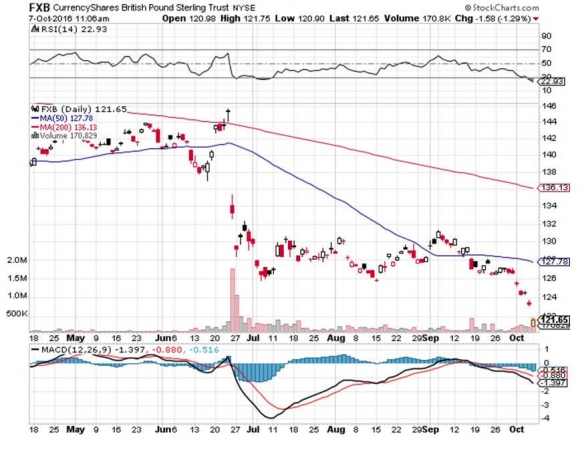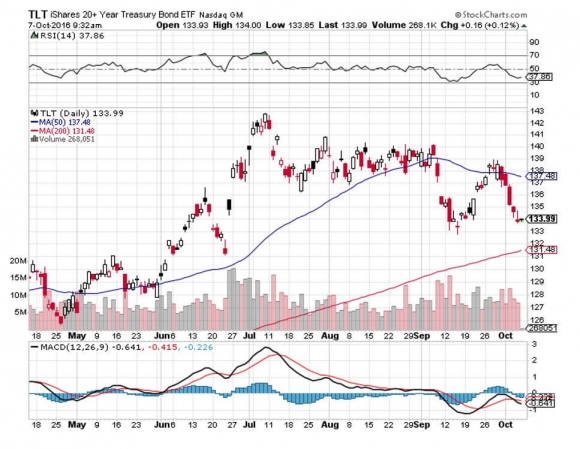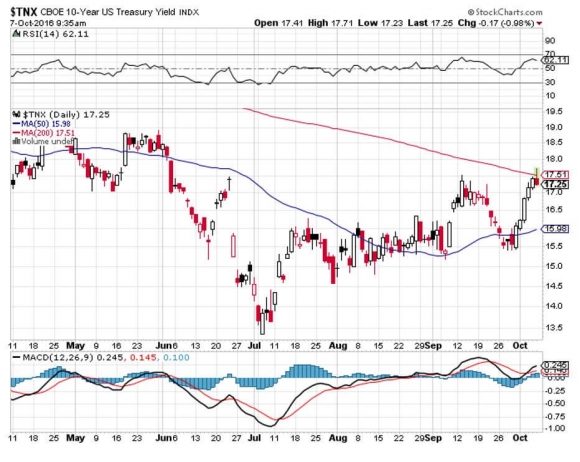On Friday, another nail was driven into the coffin for the December Fed rate rise.
That is the undeniable conclusion derived from the tepid September Non Farm Payroll Report at 156,000. The headline unemployment rate ticked up slightly to 5.0%.
The Fed tells us every day that it is data driven, and this number certainly does NOT scream that the economy is overheating and urgently needs to be reigned back.
What does all of this means for the markets?
It confirms my view that all asset classes will continue to churn sideways in narrow ranges for another month going into the election.
With the media bombarding us nonstop daily with election bombast, nobody wants to stick their neck out and front run the outcome.
Except, that is, me.
I did use the opportunity to double my long position in the US Treasury bond market while it was trading at the bottom of a four-month range.
The strike prices I am using assume that the yield on the ten-year Treasury bond (TLT) won?t rise above 2.03% over the next six weeks, a bet that I am quite happy to make.
In our relentlessly deflationary world, bond markets will continue to shock traders, investors, and financial advisors with ultra low yields.
The long side entry point for bonds was created by a run in the economic data last week that suddenly turned positive.
The final read on Q2 GDP bumped up to 1.4%. Then we saw a leap in the September Services ISM from 51.4 to 57.1. September Non Manufacturing ISM rocketed from 51.4 to 60.3.
After months of uninspiring reports, this batch served as a sudden wakeup call for bond owners.
The August payroll report was revised upward from 151,000 to 167,000.
Professional and business services did the heavy lifting, up +67,000. Health care was up 33,000, while restaurants were up 30,000.
The U-6 long-term structural unemployment rate held steady at 9.7%.
The other big shocker last week was the flash crash in the British pound (FXB), which plunged an eye popping 6% in two minutes.
This was a capitulation move resulting from the UK government?s decision to move forward with a ?hard? Brexit. England is getting so cheap that I can?t afford NOT to return next summer.
Of course, the principal volatility event for the week takes place at 9:00 EST on Sunday night in St. Louis when the second presidential debate takes place.
If Donald Trump has learned how to debate in the past 12 days, stocks will open down triple digits on Monday morning.
I think not. The leopard does not change his spots overnight.
Monday, October 10 see the banks closed for Columbus Day, so most traders will be calling it in that day.
On Tuesday, October 11 at 6:00 AM EST we learn the National Federation of Independent Business Small Business Optimism Index. This is where the bulk of the country?s job creation comes from.
On Wednesday, October 12 at 10:00 AM EST we get the Labor Department?s JOLT Report on job openings.
On Thursday, October 13 at 8:30 AM EST we get the Weekly Jobless Claims which should confirm that employment remains at four-decade highs.
Friday, October 14 delivers us the September Retail Sales at 8:30 AM EST, and August Business Inventories at 10:00 AM EST.
We wind up with the Baker Hughes Rig Count on Friday at 1:00 PM EST. Worryingly, the trend has been up for the past 14 out of the past 15 weeks.
All in all, I expect us to continue trading in narrow ranges in what is essentially a four day week, with profits accruing only to the quick and the nimble.
Good luck and good trading.? Keep your hard hat on.
John Thomas
The Mad Hedge Fund Trader






